AI
-
 Honorary Doctorate given to 5 Domestic and Foreign Figures
KAIST will be presenting doctor degrees to 5 domestic and foreign figures that have helped development of science and technology, society, and KAIST on the 11th of February.
The degrees will be awarded to Shirley Ann Jackson President of Rensselaer Polytechnic Institute, Mrs. Oh Lee Won, Chairman Cho Chun Shik, Jang Young Shin Chairman of Aekyung Group, and Kim Young Gil President of University of Han Dong.
President Jackson will be given the Honorary Science Technology Doctorate, Mrs. Oh Lee Won, Chairman Cho Chun Shik, Chairwoman Jang Young Shin, President Kim Young Gil will be given Honorary Management Doctorate degree.
President Shirley Ann Jackson is a brilliant physicists and has great managerial skills and leadership and has been the chairperson of Nuclear Regulatory Commission, Obama ministration’s Presidential Council of Advisers on Science and Technology along with the president of the university, making great contribution to the development of science and technology and society.
President Jackson is the leading female science-engineer and has received honorary doctor degrees from 45 universities and is a proven world renowned and respected leader and scholar. She has made great impact in America and on the world in research findings as a physicist, public policies, and in terms of education.
Mrs. Oh Lee Won donated 10billion Won to KAIST with wishes that it be used as scholarship for the development of future leaders of Korea.
Mrs. Oh’s donation allowed KAIST to newly establish ‘Lee Won Assistant Professor System’ that encourages promising assistant professors to educate students and focus on research and allows KAIST to invite promising scientists.
With the new system in place, KAIST now has the foundations necessary to develop excellent scientific talents and future world leaders, giving it competitive advantage in becoming the best university in the world.
Chairman Cho Chun Shik donated his entire fortune believing that supporting the science community will improve the economy.
With the donations KAIST established the ‘Cho Chun Shik Green Transportation Graduate School’ thereby laying the foundations that will allow KAIST to tap into the rapidly growing high tech green transportation market by developing related technologies and experts in this field. This will allow KAIST to become the best university centered on fusion and compound studies.
Chairwoman Jang Young Shin is the first Korean woman CEO. She graduated from Gyoung Gi girl’s High School and majored in Chemistry in the University of Chesternut Hill. She started management in 1972 and overcame social prejudice and discrimination towards women and has made the small soap company into the Aekyung group with 20 subsidiaries.
Chairwoman Jang is currently director at KAIST. She is giving advice and encouragement so that KAIST can become the world’s best using her experiences as the vice president of the Korean Businessperson Federation and Korea Trade Federation.
Chairman Kim Young Gil has worked in NASA until he answered government’s call for help in 1979 and was made professor in the department of materials and science and engineering. He became the first president at Handong University in 1995 and has been making great effort to realize a ‘education based university’ for the development of students both academically and ethically competent.
He has implemented various educational experiments, like no major, no undergraduate studies, no affiliation, mandatory double major, no proctor tests, Asia’s first American system Law School, etc. These educational innovations are seen as the new beginning of a knowledge based society’s education of science and technology.
2011.02.21 View 10725
Honorary Doctorate given to 5 Domestic and Foreign Figures
KAIST will be presenting doctor degrees to 5 domestic and foreign figures that have helped development of science and technology, society, and KAIST on the 11th of February.
The degrees will be awarded to Shirley Ann Jackson President of Rensselaer Polytechnic Institute, Mrs. Oh Lee Won, Chairman Cho Chun Shik, Jang Young Shin Chairman of Aekyung Group, and Kim Young Gil President of University of Han Dong.
President Jackson will be given the Honorary Science Technology Doctorate, Mrs. Oh Lee Won, Chairman Cho Chun Shik, Chairwoman Jang Young Shin, President Kim Young Gil will be given Honorary Management Doctorate degree.
President Shirley Ann Jackson is a brilliant physicists and has great managerial skills and leadership and has been the chairperson of Nuclear Regulatory Commission, Obama ministration’s Presidential Council of Advisers on Science and Technology along with the president of the university, making great contribution to the development of science and technology and society.
President Jackson is the leading female science-engineer and has received honorary doctor degrees from 45 universities and is a proven world renowned and respected leader and scholar. She has made great impact in America and on the world in research findings as a physicist, public policies, and in terms of education.
Mrs. Oh Lee Won donated 10billion Won to KAIST with wishes that it be used as scholarship for the development of future leaders of Korea.
Mrs. Oh’s donation allowed KAIST to newly establish ‘Lee Won Assistant Professor System’ that encourages promising assistant professors to educate students and focus on research and allows KAIST to invite promising scientists.
With the new system in place, KAIST now has the foundations necessary to develop excellent scientific talents and future world leaders, giving it competitive advantage in becoming the best university in the world.
Chairman Cho Chun Shik donated his entire fortune believing that supporting the science community will improve the economy.
With the donations KAIST established the ‘Cho Chun Shik Green Transportation Graduate School’ thereby laying the foundations that will allow KAIST to tap into the rapidly growing high tech green transportation market by developing related technologies and experts in this field. This will allow KAIST to become the best university centered on fusion and compound studies.
Chairwoman Jang Young Shin is the first Korean woman CEO. She graduated from Gyoung Gi girl’s High School and majored in Chemistry in the University of Chesternut Hill. She started management in 1972 and overcame social prejudice and discrimination towards women and has made the small soap company into the Aekyung group with 20 subsidiaries.
Chairwoman Jang is currently director at KAIST. She is giving advice and encouragement so that KAIST can become the world’s best using her experiences as the vice president of the Korean Businessperson Federation and Korea Trade Federation.
Chairman Kim Young Gil has worked in NASA until he answered government’s call for help in 1979 and was made professor in the department of materials and science and engineering. He became the first president at Handong University in 1995 and has been making great effort to realize a ‘education based university’ for the development of students both academically and ethically competent.
He has implemented various educational experiments, like no major, no undergraduate studies, no affiliation, mandatory double major, no proctor tests, Asia’s first American system Law School, etc. These educational innovations are seen as the new beginning of a knowledge based society’s education of science and technology.
2011.02.21 View 10725 -
 Soyeon's Odyssey by Space Travel, Feb. 1, 2011
Soyeon Yi, an alumna of KAIST who joined the Soyuz TMA-12 mission to the International Space Station in 2008 and successfully returned to the Earth after completion of her mission. She is often cited as the first Korean astronaut who had spaceflight. She recently had an interview with an Australian based online newspaper that publishes space related news stories. For the interview, please go to the link.
http://www.space-travel.com/reports/Soyeon_Odyssey_999.html
2011.02.02 View 12161
Soyeon's Odyssey by Space Travel, Feb. 1, 2011
Soyeon Yi, an alumna of KAIST who joined the Soyuz TMA-12 mission to the International Space Station in 2008 and successfully returned to the Earth after completion of her mission. She is often cited as the first Korean astronaut who had spaceflight. She recently had an interview with an Australian based online newspaper that publishes space related news stories. For the interview, please go to the link.
http://www.space-travel.com/reports/Soyeon_Odyssey_999.html
2011.02.02 View 12161 -
 New Korean Robot Responds to Non-Verbal Commands
An online newspaper covering the latest headline news based on MS Windows, Internet and technology trends, Infopackets, posted an article on the research result of KAIST researchers: a robot prototype developed, which is able to respond to human’s non verbal communication.
Robots now can read human gestures and react to their subtle commands by “designing the robot’s main system to mimic the actions of a human in the same manner in which human brains function.” For details of the article, please click the link:
http://www.infopackets.com/news/technology/science/2011/20110125_new_korean_robot_responds_to_non_verbal_commands.htm
2011.01.26 View 10854
New Korean Robot Responds to Non-Verbal Commands
An online newspaper covering the latest headline news based on MS Windows, Internet and technology trends, Infopackets, posted an article on the research result of KAIST researchers: a robot prototype developed, which is able to respond to human’s non verbal communication.
Robots now can read human gestures and react to their subtle commands by “designing the robot’s main system to mimic the actions of a human in the same manner in which human brains function.” For details of the article, please click the link:
http://www.infopackets.com/news/technology/science/2011/20110125_new_korean_robot_responds_to_non_verbal_commands.htm
2011.01.26 View 10854 -
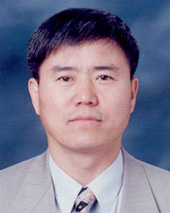 Success in differentiating Functional Vascular Progenitor Cells (VPC)
KAIST’s Professor Han Yong Man successfully differentiated vascular progenitor cells from human embryonic stem cells and reversed differentiated stem cells.
The research went beyond the current method of synthesis of embryonic body or mice cell ball culture and used the careful alteration of signal transmission system of the human embryonic stem cells to differentiate the formation of vascular progenitor cells.
The team controlled the MEK/ERK and BMP signal transmission system that serves an important role in the self replication of human embryonic stem cells and successfully differentiated 20% of the cells experimented on to vascular progenitor cells.
The vascular progenitor cells produced with such a method successfully differentiated into cells forming the endodermis of the blood vessel, vascular smooth muscle cells and hematopoietic cells in an environment outside of the human body and also successfully differentiated into blood vessels in nude mice.
In addition, the vascular progenitor cell derived from human embryonic cells successfully formed blood vessels or secreted vascular growth factors and increased the blood flow and the necrosis of blood vessels when injected into an animal with limb ischemic illness.
The research was funded by the Ministry of Education, Science and Technology, 21st Century Frontier Research and Development Institution’s Cell Application Research Department and Professor Ko Kyu Young (KAIST), Professor Choi Chul Hee (KAIST), Professor Jeong Hyung Min (Cha Medical School) and Doctor Jo Lee Sook (Researcher in Korea Bio Engineering Institute) participated in it.
The results of the research was published as the cover paper of the September edition of “Blood (IF:10.55)”, the American Blood Journal and has been patented domestically and has finished registration of foreign PCT.
The results of the experiment opened the possibility of providing a patient specific cure using stem cells in the field of blood vessel illness.
2011.01.18 View 17322
Success in differentiating Functional Vascular Progenitor Cells (VPC)
KAIST’s Professor Han Yong Man successfully differentiated vascular progenitor cells from human embryonic stem cells and reversed differentiated stem cells.
The research went beyond the current method of synthesis of embryonic body or mice cell ball culture and used the careful alteration of signal transmission system of the human embryonic stem cells to differentiate the formation of vascular progenitor cells.
The team controlled the MEK/ERK and BMP signal transmission system that serves an important role in the self replication of human embryonic stem cells and successfully differentiated 20% of the cells experimented on to vascular progenitor cells.
The vascular progenitor cells produced with such a method successfully differentiated into cells forming the endodermis of the blood vessel, vascular smooth muscle cells and hematopoietic cells in an environment outside of the human body and also successfully differentiated into blood vessels in nude mice.
In addition, the vascular progenitor cell derived from human embryonic cells successfully formed blood vessels or secreted vascular growth factors and increased the blood flow and the necrosis of blood vessels when injected into an animal with limb ischemic illness.
The research was funded by the Ministry of Education, Science and Technology, 21st Century Frontier Research and Development Institution’s Cell Application Research Department and Professor Ko Kyu Young (KAIST), Professor Choi Chul Hee (KAIST), Professor Jeong Hyung Min (Cha Medical School) and Doctor Jo Lee Sook (Researcher in Korea Bio Engineering Institute) participated in it.
The results of the research was published as the cover paper of the September edition of “Blood (IF:10.55)”, the American Blood Journal and has been patented domestically and has finished registration of foreign PCT.
The results of the experiment opened the possibility of providing a patient specific cure using stem cells in the field of blood vessel illness.
2011.01.18 View 17322 -
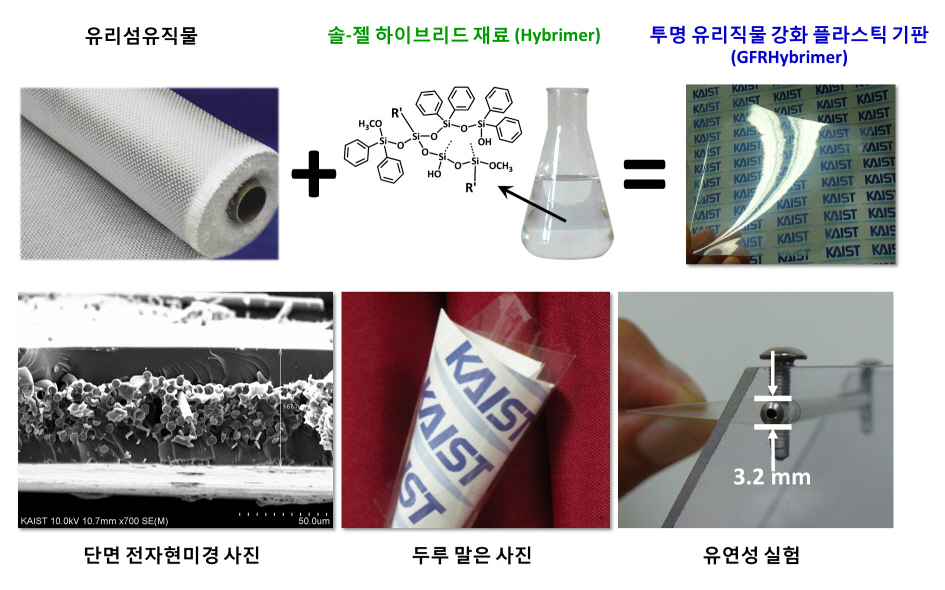 KAIST developed a plastic film board less sensitive to heat.
The research result was made the cover of magazine, Advanced Materials and is accredited to paving the way to commercialize flexible display screens and solar power cells.
Transparent plastic and glass cloths, which have a limited thermal expansion needed for the production of flexible display screens and solar power cells, were developed by Korean researchers.
The research, led by KAIST’s Professor Byoung-Soo Bae, was funded by the Engineering Research Center under the initiative of the Ministry of Education, Science and Technology and the National Research Foundation. The research result was printed as the cover paper of ‘Advanced Materials’ which is the leading magazine in the field of materials science.
Professor Bae’s team developed a hybrid material with the same properties as fiber glass. With the material, they created a transparent, plastic film sheet resistant to heat. Transparent plastic film sheets were used by researchers all over the world to develop devices such as flexible displays or solar power cells that can be fit into various living spaces. However, plastic films are heat sensitive and tend to expand as temperature increases, thereby making it difficult to produce displays or solar power cells.
The new transparent, plastic film screen shows that heat expansion index (13ppm/oC) similar to that of glass fiber (9ppm/oC) due to the presence of glass fibers; its heat resistance allows to be used for displays and solar power cells over 250oC.
Professor Bae’s team succeeded in producing a flexible thin plastic film available for use in LCD or AMOLED screens and thin solar power cells.
Professor Bae commented, “Not only the newly developed plastic film has superior qualities, compared to the old models, but also it is cheap to produce, potentially bringing forward the day when flexible displays and solar panels become commonplace. With the cooperation of various industries, research institutes and universities, we will strive to improve the existing design and develop it further.”
2011.01.05 View 18005
KAIST developed a plastic film board less sensitive to heat.
The research result was made the cover of magazine, Advanced Materials and is accredited to paving the way to commercialize flexible display screens and solar power cells.
Transparent plastic and glass cloths, which have a limited thermal expansion needed for the production of flexible display screens and solar power cells, were developed by Korean researchers.
The research, led by KAIST’s Professor Byoung-Soo Bae, was funded by the Engineering Research Center under the initiative of the Ministry of Education, Science and Technology and the National Research Foundation. The research result was printed as the cover paper of ‘Advanced Materials’ which is the leading magazine in the field of materials science.
Professor Bae’s team developed a hybrid material with the same properties as fiber glass. With the material, they created a transparent, plastic film sheet resistant to heat. Transparent plastic film sheets were used by researchers all over the world to develop devices such as flexible displays or solar power cells that can be fit into various living spaces. However, plastic films are heat sensitive and tend to expand as temperature increases, thereby making it difficult to produce displays or solar power cells.
The new transparent, plastic film screen shows that heat expansion index (13ppm/oC) similar to that of glass fiber (9ppm/oC) due to the presence of glass fibers; its heat resistance allows to be used for displays and solar power cells over 250oC.
Professor Bae’s team succeeded in producing a flexible thin plastic film available for use in LCD or AMOLED screens and thin solar power cells.
Professor Bae commented, “Not only the newly developed plastic film has superior qualities, compared to the old models, but also it is cheap to produce, potentially bringing forward the day when flexible displays and solar panels become commonplace. With the cooperation of various industries, research institutes and universities, we will strive to improve the existing design and develop it further.”
2011.01.05 View 18005 -
 New Year's Message from President Nam-Pyo Suh
President Nam-Pyo Suh delivered a New Year’s message on January 3, 2011. While announcing plans to celebrate the 40th anniversary of KAIST throughout this year including a long-term development strategy for the university, Vision 2025, the president assessed the past accomplishments made in 2010 and laid out future prospects for 2011. The full text of his speech is attached below.
2011.01.05 View 10997
New Year's Message from President Nam-Pyo Suh
President Nam-Pyo Suh delivered a New Year’s message on January 3, 2011. While announcing plans to celebrate the 40th anniversary of KAIST throughout this year including a long-term development strategy for the university, Vision 2025, the president assessed the past accomplishments made in 2010 and laid out future prospects for 2011. The full text of his speech is attached below.
2011.01.05 View 10997 -
 KAIST sells eight HUBO 2 robots to US and Singapore.
HUBO, a humanoid robot developed by KAIST, has made its journey to the US and Singapore for the development of robotics engineering in those nations. Details on the movements of HOBO being exported aboard, please click the link of the news article:
http://www.slashgear.com/kaist-sells-eight-hubo-2-robots-to-us-and-singapore-14119320/
2010.12.20 View 12884
KAIST sells eight HUBO 2 robots to US and Singapore.
HUBO, a humanoid robot developed by KAIST, has made its journey to the US and Singapore for the development of robotics engineering in those nations. Details on the movements of HOBO being exported aboard, please click the link of the news article:
http://www.slashgear.com/kaist-sells-eight-hubo-2-robots-to-us-and-singapore-14119320/
2010.12.20 View 12884 -
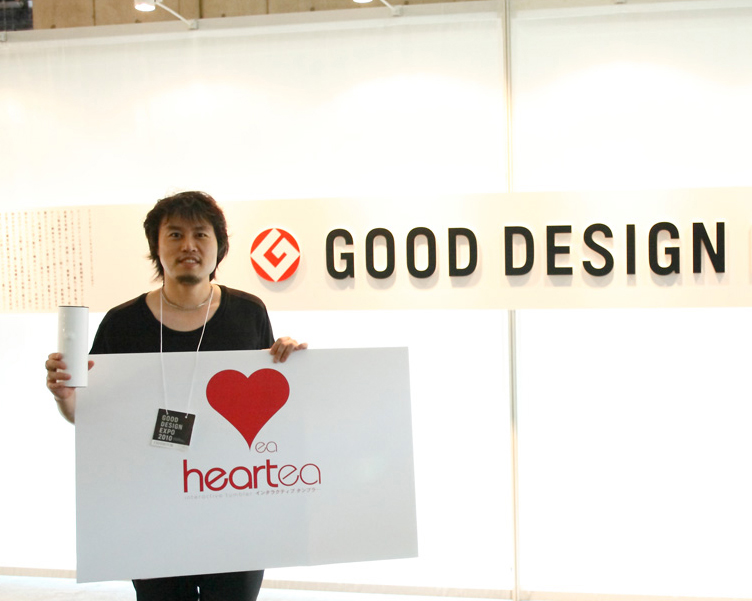 Professor Bae of Industrial Design Wins Good Design Award.
Professor Bae Sang Min’s research team of the Industrial Design Department received a G-Mark on the Product Design Section from the Good Design Awards 2010 organized by the Japan Industrial Design Promotion Organization through the exhibition of a Green Sharing Project, Heartea.
Heartea is a tumbler that allows the user to easily know the temperature of the liquid contained inside. Heartea is a name that combines Heart and Tea to refer to a tumbler that contains heart-warming tea.
Heartea was designed and produced by Professor Bae’s research team and was funded by GS Caltex. World Vision selected charity targets and oversaw distribution, and all of the sales income (about 200 million won) was donated as a scholarship to teenagers with financial difficulties.
The project has begun in 2006, and its accumulative sales are 1.7 billion won. Twenty million won is donated to 147 teenagers every year as scholarship, and through annual sharing camp, social leaders mentor teenagers to help them achieve their dreams.
The Good Design Award organized annually by Japan Industrial Design Promotion Organization has a fifty year tradition and is one of the world’s top four design contests with 6,000 submissions from 50 different countries participated.
Professor Bae’s team has won three of the top four design contests including the German Red Dot Product Award and the American IDEA Product Award.
Along with Heartea, both of foldable MP3 in 2008 and natural humidifier Lovepot in 2009 won an award from these four contests.
“Through continuous research, I hope to create the world’s best philanthropy design research center to help Third World countries and the neglected. I want to participate in creating a better world through design,” said Professor Bae.
2010.11.05 View 14653
Professor Bae of Industrial Design Wins Good Design Award.
Professor Bae Sang Min’s research team of the Industrial Design Department received a G-Mark on the Product Design Section from the Good Design Awards 2010 organized by the Japan Industrial Design Promotion Organization through the exhibition of a Green Sharing Project, Heartea.
Heartea is a tumbler that allows the user to easily know the temperature of the liquid contained inside. Heartea is a name that combines Heart and Tea to refer to a tumbler that contains heart-warming tea.
Heartea was designed and produced by Professor Bae’s research team and was funded by GS Caltex. World Vision selected charity targets and oversaw distribution, and all of the sales income (about 200 million won) was donated as a scholarship to teenagers with financial difficulties.
The project has begun in 2006, and its accumulative sales are 1.7 billion won. Twenty million won is donated to 147 teenagers every year as scholarship, and through annual sharing camp, social leaders mentor teenagers to help them achieve their dreams.
The Good Design Award organized annually by Japan Industrial Design Promotion Organization has a fifty year tradition and is one of the world’s top four design contests with 6,000 submissions from 50 different countries participated.
Professor Bae’s team has won three of the top four design contests including the German Red Dot Product Award and the American IDEA Product Award.
Along with Heartea, both of foldable MP3 in 2008 and natural humidifier Lovepot in 2009 won an award from these four contests.
“Through continuous research, I hope to create the world’s best philanthropy design research center to help Third World countries and the neglected. I want to participate in creating a better world through design,” said Professor Bae.
2010.11.05 View 14653 -
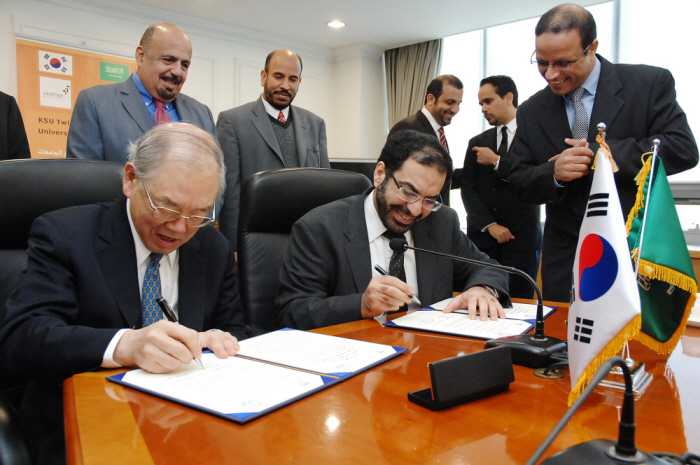 Minister of Higher Education of Saudi Arabia Visited KAIST to Sign Agreement on Joint Research Projects
Khaled bin Mohammad Al-Anqari, the Minister of Higher Education of Saudi Arabia, visited KAIST on October 26th to conclude a joint agreement with KAIST.
The group of Saudi Arabian visitors included Abdullah bin Abdularhman Al-Othman, President of the King Saud University, Osama bin Sadiq Tayeb, President of King Abdulaziz University, and Khalid bin Salih Al-Sultan, President of the best Saudi Arabian technological university, King Fahad University of Petroleum and Minerals.
Through research agreement between KAIST and the King Saud University and King Fahad University of Petroleum and Minerals, joint research projects, mutual visitations of research professors, interchange of academic programs, joint seminars and scientific societies will be held to promote the lively interchange between higher education institutions of Korea and Saudi Arabia.
In particular, King Saud University and KAIST has signed an agreement on joint research projects in the fields of “Solar-Ocean Thermal Exchange Desalination,” “Develop New Energy Management Service for Residential and Commercial Customers Using Smart Metering and Sensor Network Information” and “Superior Production of Lactic Acid from Saudi Dates Using Bioprocess Technology.”
The projects will be funded by the Saudi Arabian government, and their scope will be determined in the future
“Compared to the robust industrial economic interactions between the Middle East and Korea, the interchange of the two countries’ higher education institutions has been poor,” said Jong Hyun Kim, Visiting Professor of Nuclear & Quantum Engineering Department of KAIST who will be conducting one of the joint programs with the Electrical Engineering Department of the King Saud University. “Like this joint research, I hope KAIST will, in many different ways, lead the way in cooperating and interacting with higher education institutions of the Middle EAST.”
Al-Anquari, Minister of Higher Education of Saudi Arabia, who showed great interest in KAIST’s innovative research and high technology development, expressed his will to put more effort into extending the interchange between universities of Saudi Arabia and of Korea, including KAIST.
2010.11.03 View 18944
Minister of Higher Education of Saudi Arabia Visited KAIST to Sign Agreement on Joint Research Projects
Khaled bin Mohammad Al-Anqari, the Minister of Higher Education of Saudi Arabia, visited KAIST on October 26th to conclude a joint agreement with KAIST.
The group of Saudi Arabian visitors included Abdullah bin Abdularhman Al-Othman, President of the King Saud University, Osama bin Sadiq Tayeb, President of King Abdulaziz University, and Khalid bin Salih Al-Sultan, President of the best Saudi Arabian technological university, King Fahad University of Petroleum and Minerals.
Through research agreement between KAIST and the King Saud University and King Fahad University of Petroleum and Minerals, joint research projects, mutual visitations of research professors, interchange of academic programs, joint seminars and scientific societies will be held to promote the lively interchange between higher education institutions of Korea and Saudi Arabia.
In particular, King Saud University and KAIST has signed an agreement on joint research projects in the fields of “Solar-Ocean Thermal Exchange Desalination,” “Develop New Energy Management Service for Residential and Commercial Customers Using Smart Metering and Sensor Network Information” and “Superior Production of Lactic Acid from Saudi Dates Using Bioprocess Technology.”
The projects will be funded by the Saudi Arabian government, and their scope will be determined in the future
“Compared to the robust industrial economic interactions between the Middle East and Korea, the interchange of the two countries’ higher education institutions has been poor,” said Jong Hyun Kim, Visiting Professor of Nuclear & Quantum Engineering Department of KAIST who will be conducting one of the joint programs with the Electrical Engineering Department of the King Saud University. “Like this joint research, I hope KAIST will, in many different ways, lead the way in cooperating and interacting with higher education institutions of the Middle EAST.”
Al-Anquari, Minister of Higher Education of Saudi Arabia, who showed great interest in KAIST’s innovative research and high technology development, expressed his will to put more effort into extending the interchange between universities of Saudi Arabia and of Korea, including KAIST.
2010.11.03 View 18944 -
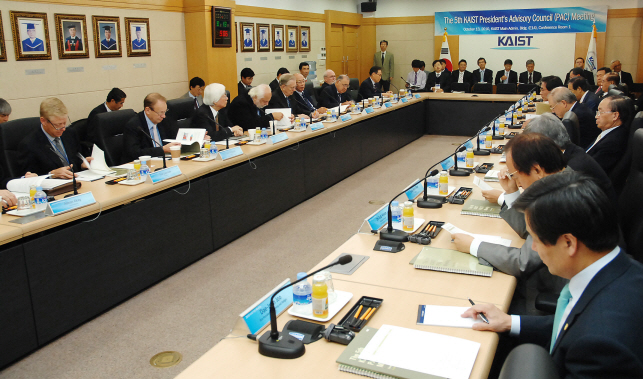 The 5th KAIST President's Advisory Council Held
The 5th KAIST President’s Advisory Council (PAC) was held on October 13 at KAIST. At PAC, President Suh reported important present conditions and achievements of KAIST and introduced the ‘KAIST Vision 2025’ to members of the council which includes top national and international professionals of the Industry-University-Institute collaboration.
Additionally, six latest research assignments of KAIST were selected and presented to the PAC. President Suh also presented the Freshman Design Course, Renaissance Ph.D. Program, KAIST-KUSTAR Cooperation Program, and the visions of Neil Pappalardo Medical Center and received advice from the council.
Through PAC, KAIST receives various strategic advices to develop KAIST into a global science and technology university, direct and indirect support on the KAIST development fund collection, and support to create, maintain and develop cooperation relationships with national and international distinguished institutes linked to advisory council members.
International PAC council members include Donald C. W. Kim, CEO of AMKOR A&E; Neil Pappalardo, former MEDITECH CEO; John R. Holzrichter, President of the Fannie and John Hertz Foundation; Papken Der Torossian, CEO of Vistec Semiconductor Systems Group; Adnan Akay, Vice President of Bilkent University; Arden Bement, Director of the National Science Foundation (NSF); Tod Laursen, President of KUSTAR in the UAE; Lars Pallesen, President of the Technical University of Denmark and Hiroyuki Yoshikawa, former President of the University of Tokyo.
National PAC council members include Kim Woo Sik, President of the Creativity Engineering Institute; Jin Hyun Kim, Chairman of the Committee for the Establishment of the National Museum of Korean Contemporary History; Myung Ja Kim, President of the Green Korea 21 Forum; Lee Hee Gook, President of LG Siltron; Lyu keun Chul, Professor of Bauman Moscow State Technical University; Bo-Young Kang, President of Andong Medical Group; Kwon Oh-Gap, former Vice Minister of Science and Technology; Sang chun Lee, President of Korea Institute of Machinery & Materials; and Bae Soo Hoon, Director of the Museum of Contemporary Art, Korea.
2010.10.20 View 16629
The 5th KAIST President's Advisory Council Held
The 5th KAIST President’s Advisory Council (PAC) was held on October 13 at KAIST. At PAC, President Suh reported important present conditions and achievements of KAIST and introduced the ‘KAIST Vision 2025’ to members of the council which includes top national and international professionals of the Industry-University-Institute collaboration.
Additionally, six latest research assignments of KAIST were selected and presented to the PAC. President Suh also presented the Freshman Design Course, Renaissance Ph.D. Program, KAIST-KUSTAR Cooperation Program, and the visions of Neil Pappalardo Medical Center and received advice from the council.
Through PAC, KAIST receives various strategic advices to develop KAIST into a global science and technology university, direct and indirect support on the KAIST development fund collection, and support to create, maintain and develop cooperation relationships with national and international distinguished institutes linked to advisory council members.
International PAC council members include Donald C. W. Kim, CEO of AMKOR A&E; Neil Pappalardo, former MEDITECH CEO; John R. Holzrichter, President of the Fannie and John Hertz Foundation; Papken Der Torossian, CEO of Vistec Semiconductor Systems Group; Adnan Akay, Vice President of Bilkent University; Arden Bement, Director of the National Science Foundation (NSF); Tod Laursen, President of KUSTAR in the UAE; Lars Pallesen, President of the Technical University of Denmark and Hiroyuki Yoshikawa, former President of the University of Tokyo.
National PAC council members include Kim Woo Sik, President of the Creativity Engineering Institute; Jin Hyun Kim, Chairman of the Committee for the Establishment of the National Museum of Korean Contemporary History; Myung Ja Kim, President of the Green Korea 21 Forum; Lee Hee Gook, President of LG Siltron; Lyu keun Chul, Professor of Bauman Moscow State Technical University; Bo-Young Kang, President of Andong Medical Group; Kwon Oh-Gap, former Vice Minister of Science and Technology; Sang chun Lee, President of Korea Institute of Machinery & Materials; and Bae Soo Hoon, Director of the Museum of Contemporary Art, Korea.
2010.10.20 View 16629 -
 KAIST Animation 'Captain Banana' To Be Shown at SIGGRAPH Asia 2010
‘Captain Banana,’ a short animation created by researchers of Associate Professor Junyong Noh’s Visual Media Laboratory and current students of the Graduate School of Culture Technology (CT), will be shown at SIGGRAPH Asia 2010 this December 15th to 18th.
Following last year’s screening of ‘Taming the Cat’ at the SIGGRAPH CG Animation Festival in the United States, Professor Noh’s work has been chosen to be shown at global CG animation festivals for two years in a row.
Since the first exhibition by ACM in 1974, SIGGRAPH has become a global computer graphic festival that has a strong influence on the global CG and interactive technology industry. The Asian version of SIGGRAPH, SIGGRAPH Asia has been held annually at Singapore in 2008 and Yokohama, Japan in 2009. This year’s SIGGRAPH Asia will be held at COEX in Seoul from December 15th to 18th.
‘Captain Banana’ is a five minute film about Captain Banana, who explains recent issues over sex including unwanted pregnancies, the eradication of abortions and prevention of AIDS through a series of funny situations with his ten little friends.
“Along with being chosen for screening at global CG animation festivals two years in a row, this year’s selection is significant in that the VM Lab has increased the efficiency of the creating process by using technology we have developed on our own,” said Professor Noh.
The production period took approximate five months with approximately 20 current students of CT and five researchers of the Visual Media Lab.
2010.10.20 View 12684
KAIST Animation 'Captain Banana' To Be Shown at SIGGRAPH Asia 2010
‘Captain Banana,’ a short animation created by researchers of Associate Professor Junyong Noh’s Visual Media Laboratory and current students of the Graduate School of Culture Technology (CT), will be shown at SIGGRAPH Asia 2010 this December 15th to 18th.
Following last year’s screening of ‘Taming the Cat’ at the SIGGRAPH CG Animation Festival in the United States, Professor Noh’s work has been chosen to be shown at global CG animation festivals for two years in a row.
Since the first exhibition by ACM in 1974, SIGGRAPH has become a global computer graphic festival that has a strong influence on the global CG and interactive technology industry. The Asian version of SIGGRAPH, SIGGRAPH Asia has been held annually at Singapore in 2008 and Yokohama, Japan in 2009. This year’s SIGGRAPH Asia will be held at COEX in Seoul from December 15th to 18th.
‘Captain Banana’ is a five minute film about Captain Banana, who explains recent issues over sex including unwanted pregnancies, the eradication of abortions and prevention of AIDS through a series of funny situations with his ten little friends.
“Along with being chosen for screening at global CG animation festivals two years in a row, this year’s selection is significant in that the VM Lab has increased the efficiency of the creating process by using technology we have developed on our own,” said Professor Noh.
The production period took approximate five months with approximately 20 current students of CT and five researchers of the Visual Media Lab.
2010.10.20 View 12684 -
 International Workshop on EEWS 2010 was held.
On October 7 and 8th at Fusion Hall of KI Building, KAIST, the 2010 International Workshop on EEWS (Energy, Environment, Water, and Sustainability) was held.
The third to be held, forty national and international academic professionals including Mark Shannon, professor at University of Illinois at Urbana-Champaign, Domen Kazunari, Tokyo University professor, Dong Sub Kim, CTO of SK Energy and Doyoung Seung, Senior Vice President of GS Caltex, participated at this year’s workshop.
In twelve sessions, themes including Artificial Photosynthesis, Wireless Power Transfer, Green Aviation, Safe Nuclear Fuel Reuse, Fuel Cells in Action, LED 2.0, Foundation of Energy-Water Nexus, and Flexible Battery & Solar Cell were presented and discussed.
“Through this workshop, current EEWS policy and research progress from different countries and the future of related technologies will be foreseen,” said Jae Kyu Lee, Dean of KAIST EEWS Initiative. “I hope it became an opportunity to create cooperative relationships with leading researchers.”
EEWS is a research project conducted by KAIST to solve global issues that mankind faces today such as depletion of energy, environmental pollution, water shortage, and sustainability.
2010.10.15 View 20303
International Workshop on EEWS 2010 was held.
On October 7 and 8th at Fusion Hall of KI Building, KAIST, the 2010 International Workshop on EEWS (Energy, Environment, Water, and Sustainability) was held.
The third to be held, forty national and international academic professionals including Mark Shannon, professor at University of Illinois at Urbana-Champaign, Domen Kazunari, Tokyo University professor, Dong Sub Kim, CTO of SK Energy and Doyoung Seung, Senior Vice President of GS Caltex, participated at this year’s workshop.
In twelve sessions, themes including Artificial Photosynthesis, Wireless Power Transfer, Green Aviation, Safe Nuclear Fuel Reuse, Fuel Cells in Action, LED 2.0, Foundation of Energy-Water Nexus, and Flexible Battery & Solar Cell were presented and discussed.
“Through this workshop, current EEWS policy and research progress from different countries and the future of related technologies will be foreseen,” said Jae Kyu Lee, Dean of KAIST EEWS Initiative. “I hope it became an opportunity to create cooperative relationships with leading researchers.”
EEWS is a research project conducted by KAIST to solve global issues that mankind faces today such as depletion of energy, environmental pollution, water shortage, and sustainability.
2010.10.15 View 20303